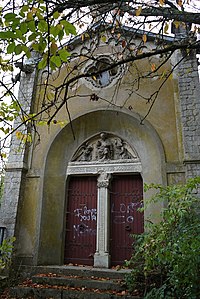Orthodox Church of the Gauls
| Orthodox Church of the Gauls | |
|---|---|
 Orthodox Church of the Gauls chapel of Rémicourt, Villers-lès-Nancy | |
| Classification | Western Orthodox |
| Associations | Communion of Western Orthodox Churches |
| Official website | eglise-orthodoxe.eu |
The Orthodox Church of the Gauls (OCG; French: Église Orthodoxe des Gaules, EOG) is a self-governing Christian church formed in 2006.
The OCG is part of the Communion of Western Orthodox Churches.
Beliefs
[edit]The OCG professes the doctrinal teachings of the ecumenical councils of Nicea, Constantinople, and Ephesus.[1]
History
[edit]Eastern Orthodoxy
[edit]In 1924 Louis-Charles Winnaert, a former Roman Catholic priest, along with his adherents, formed the Eglise catholique évangélique (Evangelical Catholic Church), an Independent Catholic church.
Differences between the liturgical vision of Kovalevsky, on the one hand, and Chambault and Mensbrugghe, on the other, as well as news of the plans of Patriarch Alexy I of Moscow to have Kovalevsky consecrated as bishop of the WOC, led to conflict. False accusations of impropriety by Kovalevsky, brought by Chambault and Mensbrugghe in 1953, resulted in the decision being taken by the Patriarch to remove Kovalevsky from his role of administrator of the WOC, without further investigation. When the deception was subsequently realised after an eventual investigation in September of the same year, an envoy was sent to Kovalevsky to apologise for the hasty judgement. However, it was too late. Kovalevsky had already resigned from the ROC, and the parishes and majority of the clergy of the WOC had departed with him.[2]
Oriental Orthodoxy
[edit]After a period of negotiation, a group of the Orthodox Church of the Gauls was welcomed into the fold of the French Coptic Orthodox Church (FCOC) in 2000.[3] The group comprised the following communities, as well as a number of other disparate clergy:
- The monastic community of Saint Michel and Saint Martin, which follows the Rule of Saint Benedict.
- The Bethany Community – a lay community for hesychastic spirituality, led at the time by Father Alphonse and Rachel Goettmann at Gorze.[4]
However, some years later, in 2005, Abba Marcos issued a letter insisting that the clergy must adopt the Coptic rite and, moreover, making the claim that the use of the western liturgies had never been authorised by him. Having been afforded no opportunity to appeal against this decision, the affected clergy petitioned Pope Shenouda III of Alexandria in February 2006 for an audience to discuss the matter further. When they had not received a response by June of the same year, it became clear that remaining with the FCOC would mean abandoning their Western Orthodox liturgical and spiritual heritage. Therefore, the clergy resigned from the FCOC, taking their communities with them.[5][discuss]
Communion of Western Orthodox Churches
[edit]In 2007, the Orthodox Church of the Gauls, the French Orthodox Church, and the Celtic Orthodox Church established the Communion of Western Orthodox Churches.
In the years of stability since then, through organic expansion and the founding of new communities, the OCG has grown numerically and today comprises a number of parishes, missions, and monastic houses in France, Belgium, Spain, Poland, the United States of America, Brazil, and the United Kingdom.[6]
In August 2018, the clergy of the Priestly Fraternity of Ss Cyril and Methodius, along with their congregations, were received by Bishop Gregory and established by his decree as the Polish exarchate of the OCG, with Bishop Gorazd Sawicki as its exarch.[7]
Relations with other churches
[edit]Since April 2009[update], the OCG is in full communion with the Ukrainian Orthodox Church in America.[8][a]
Notes
[edit]References
[edit]- ^ "Manifesto of the Orthodox Church of the Gauls".
We confess the primitive faith of the Ecumenical Councils of Nicaea (325), Constantinople (381), and Ephesus (431). By this confession we take as our spiritual reference point the so-called 'Oriental' Orthodox Churches, rejecting any charges of 'monophysitism' which have been wrongfully linked to this confession.
- ^ http://sainte-genevieve-paris.fr/la-confrerie-saint-photius-la-rupture-de-1953-conference-ete-2013-complement-de-janv-2014 The canonical rupture of 1953 between The Orthodox Church of France and the Moscow Patriarchate, or "How the murderers accuse the victim"
- ^ Abba Marcos; Goettmann, Alphonse (30 November 2000). "Protocole de reception dans l'Église Copte Orthodoxe de France de la Communauté Ecclésiale Notre-Dame & Saint Thiébault" [Reception protocol of the Ecclesial Community Our Lady & St Thiebault into the Coptic Orthodox Church of France]. eocf.free.fr (in French). Etudes sur l'Orthodoxie Copte en France. p. 1/2. Archived from the original on 29 April 2016. Retrieved 29 April 2016. Additional pages archived on 2016-04-29: p. 2/2.
- ^ Nottingham, Theodore J. "Bethanie: a place of renewal". centre-bethanie.org. Gorze, FR: Centre de Rencontres Spirituelles. Archived from the original on 5 March 2016. Retrieved 29 April 2016.
- ^ "Dossier rupture d'un groupe de prêtres avec l'Église Orthodoxe Copte Francaise" [Record of the separation of a priests groups from the French Coptic Orthodox Church]. eocf.free.fr (in French). Etudes sur l'Orthodoxie Copte en France. Archived from the original on 31 October 2014.
- ^ "Annuaire de l'Eglise" [Directory of the Church]. eglise-orthodoxe.eu (in French). Luzé: Eglise Orthodoxe des Gaules. Archived from the original on 1 August 2016. Retrieved 12 September 2016.
- ^ "Relations inter-juridictionnelles".
- ^ "Interjurisdictional intercommunion". uaocamerica.org. Ukrainian Orthodox Church in America. Archived from the original on 24 April 2016.
- ^ "A history of our jurisdiction". uaocamerica.org. Ukrainian Orthodox Church in America. Archived from the original on 24 February 2014.
- This article incorporates text from Orthodox Church of the Gauls at OrthodoxWiki which is licensed under the CC-BY-SA and GFDL.
External links
[edit]- Official website (in French) (in French with some English pages)

